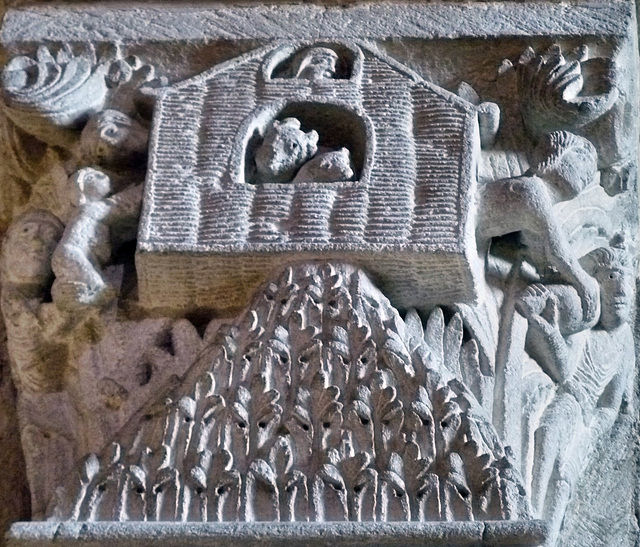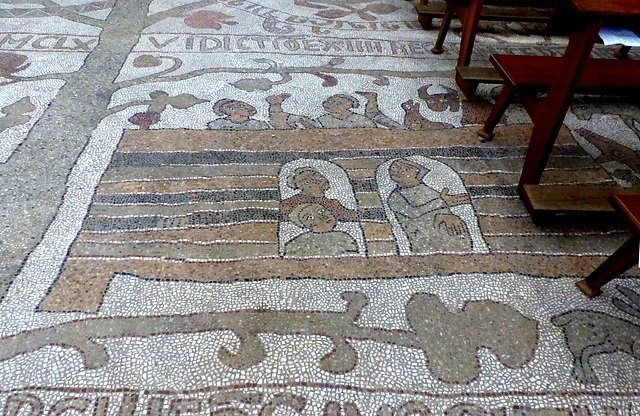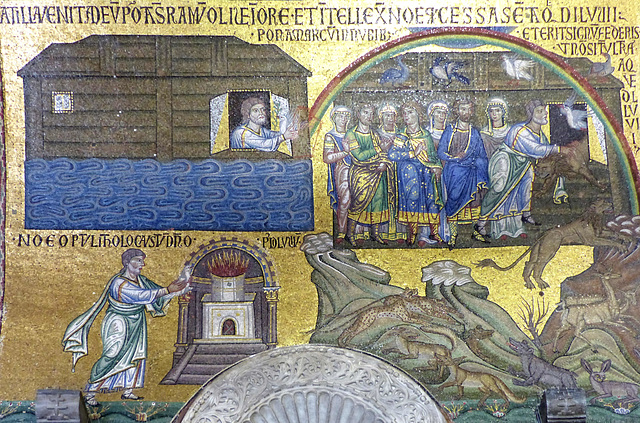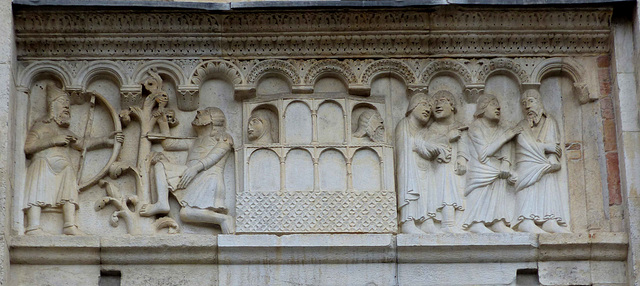
Noah´s many arks
The narrative of a great flood is known since Sumerian time. In the "Epic of Gilgamesh" the ark is a kind of round floating island. Noah`s ark had many forms in the imagination of medieval artists.
Autun - Cathédrale Saint-Lazare
There had been a church here earlier, that was just too small, when Autun became a centre of pilgrimage, after relics of St. Lazarus were kept here since about 970. Just like Vezelay, only 90kms north, where the relics of St. Lazarus´ sister St. Maria Magdalena were kept at that time. So in 1120, it was decided to construct this larger and more suitable cathedral. At that time this construction was influenced by Cluny III, that was a little older. After severe damage during the Hundred Years' War, rebuilding and remodelling the romanesque structure started. The central nave never changed - and the many carved capitals.
Some of these works were taken down, during the renovation by Viollet-le-Duc and are now shown in the "Salle Capitulaire", where it is interesting to see the carvings at eye level.
This carved capital depicts the Ark, being boarded by Noah´s extended family - and all the animals, that should be saved from the flood. Noah (seen in the top window) has placed the Ark on top of a wooded mountain, so there would be a little more time before the waves would carry the Ark away. Two animals look out of the central window. The Ark seems to be a woven or braided house- or basketlike boat. The carving is very symmetrical. The ark is very small, same like the mountain, but as symbols, they are clearly recognisable.
Auxerre - Cathédrale Saint-Étienne
The Cathédrale Saint-Étienne seen today is actually the 5th on the spot.
The erection started in 1215 around the same time, when the building of the cathedrals in Reims and Amiens started. The choir was completed in 1235. The stained glass of the choir windows was created until 1250. The same time, the construction of the facade began. Around 1300, construction began on the southern arm of the transept.
The sculptured portal is dated to around 1320. The nave was built from around 1320–1350, but the Hundred Years' War slowed the work down and delayed the completion of the south aisle until 1378. The north transept and the towers had not begun at the beginning of the 15th century. In 1478, the nave was vaulted and in 1500 work on the north tower began and was completed after 43 years. The south tower was never completed.
A detail from the western facade.
Noah´s ark
Otranto - Cattedrale di Otranto
Otranto occupies the site of an ancient Greek city. It gained importance in Roman times, as it was the nearest port to the eastern coast of the Adriatic Sea.
After the end of the Roman Empire, it was in the hands of the Byzantine emperors until it surrendered to the Norman troops of Robert Guiscard in 1068. The Normans fortified the city and built the cathedral, that got consecrated in 1088. When Henry VI., son of Emperor Frederick Barbarossa, married Constanze of Sicily in 1186 Otranto came under the rule of the Hohenstaufen and later in the hands of Ferdinand I of Aragón, King of Naples.
Between 1480 and 1481 the "Ottoman invasion" took place here. Troops of the Ottoman Empire invaded and laid siege to the city and its citadel. Legends tell that more than 800 inhabitants were beheaded after the city was captured. The "Martyrs of Otranto" are still celebrated in Italy, their skulls are on display in the cathedral. A year later the Ottoman garrison surrendered the city following a siege by Christian forces and the intervention of Papal forces.
-
Otranto had been one of the last Byzantine strongholds in Apulia, but finally Robert Guiscard could take it. It had probably been such a stronghold, as Otranto had hosted an autocephalous bishopric, only dependent of the patriarchal see of Byzantium since 968. So (Roman) Catholicism had to perform something "convincing" for the so long (Byzantine) Orthodox christians. One was to erect a huge church. The Otranto Cathedral was erected, over ruins of a Paleo-christian church from 1080 on and was consecrated in 1088. It is 54 metres long by 25 metres wide and is built on 42 monolithic granite and marble columns.
I had come to Otranto, to see the mosaic. I had planned to stay one night in Otranto, I spent three nights - and still had not seen all the details. I was so overwhelmed, that I took hundreds of photos, but the mosaic is "endless". I will upload only a couple.
It was created by a monk named Pantaleon and his workshop between 1163 and 1165. Pantaleon lived at the monastery San Nicola di Casole, located a few kilometres south of Otranto.
The mosaic covers the nave, both aisles, the apse and the presbytery. This sums up to a total of 1596 m². About 10 000000 (10 million!) "tesserae" were used.
There are scholars, who have counted up to 700 different "stories", that are told here. Though, these "stories" are often disputed, as today's interpretations are mostly very "vague". German historian Carl Arnold Willemsen published the most important book about the mosaic in Italian " L'enigma di Otranto", that since the 1970s is translated in many languages. I followed his theories.
As the church is a parish church, there are benches placed on the mosaic floor. Only for the Sunday service, the ropes are open so that the parishioners can reach the benches. I stayed up to Sunday to mix with the locals.
Noah's Ark
Beaune - Collégiale Notre-Dame de Beaune
Beaune, in the centre of the Department "Côte-d’Or", is one of the key wine centres in France. It is the centre of Burgundy wine production.
and business. The annual wine auction of the "Hospices de Beaune" is worldwide noticed and maybe the most important auction in France.
The collegiate was founded in Beaune within the 10th century, the building of this church, which is parish church since the French Revolution, started in romanesque style within the 12th century. The Romanesque capitals are very detailed and have a specific "soft" style. Passengers are leaving Noah's Ark.
Wismar - Heiligen-Geist-Kirche
Slavic Obodrites lived in the area, where Wismar is now, until the end of the 12th century.
The exact date of the city's foundation is not clear, it had civic rights already in 1229 when migrants from Holstein and Westphalia settled here. The "Lübsches Stadtrecht" (town law) was confirmed in 1266. In 1259 Wismar joined a defensive agreement with Lübeck and Rostock, in order to counter the numerous Baltic pirates. Subsequently, more cities would agree to cooperate as commerce and trade were increasingly coordinated and regulated. These policies would provide the basis for the development of the "Hanseatic League". By the 13th and 14th centuries, Wismar had grown into a flourishing Hanseatic trading hub.
In 1632, during the Thirty Years' War, Sweden conquered the city, and the Swedish Crown received in the Peace of Westphalia in 1648 after the end of the Thirty Years' War.
Swedish rule over Wismar ended de facto in 1803 when Sweden pledged the city to the Duchy of Mecklenburg-Schwerin for 99 years. Formally, Wismar reverted to Germany in 1903 and Sweden waived its right to redeem the pledge.
Wismar is a typical representative of the Hanseatic League with its city-wide Brick Gothic structures and gabled patrician houses and has alongside the historical old town of Stralsund been declared the UNESCO World Heritage Site "Historic Centres of Stralsund and Wismar".
The "Heiligen Geist Kirche" (Holy Spirit Church) is part of the "Heiligen Geist Hospital", which was founded in the middle of the 13th century as a hospital for the poor. In 1323, the hospital was placed under papal protection and construction of the present church began. The main altar was consecrated in 1326.
Today's single-nave brick building essentially dates from the first third of the 14th century and was initially a place of worship, clinic and hostel at the same time.
The painted plank ceiling of the hospital church shows a depiction of the biblical story in 26 pictures, which are depicted in medallions.
The Flood ends, Noah is saved. Behind him the ark.
Venezia - Basilica di San Marco
Venice (ital. Venezia) is one of the most important tourist destinations worldwide with about 30 million visitors each year.
I have already uploaded dozens of shots from previous visits, so I´ll try to cut down the number of uploads this time.
Noah's Ark
Venezia - Basilica di San Marco
Venice (ital. Venezia) is one of the most important tourist destinations worldwide with about 30 million visitors each year.
I have already uploaded dozens of shots from previous visits, so I´ll try to cut down the number of uploads this time.
Noah's Ark
Modena - Duomo
Modena, an Etruscan foundation, was an important city in the Roman Empire and a stronghold against the barbarian attacks at its end. It is said that it was never sacked by Attila, for a dense fog hid it (a miracle said to be provided by Saint Geminianus, patron of Modena), but it was eventually buried by a great flood in the 7th century and abandoned.
Towards the end of the 9th century, Modena was rebuilt and fortified by its bishop Ludovicus. When the construction of the cathedral began in 1099, the city was part of the possessions of Margravine Matilda of Tuscia. But when the building was consecrated by Lucius III in 1184, it was a free commune. In the wars between Frederick II and Gregory IX, it sided with the emperor.
Two churches built since the 5th century on the site of the present cathedral were both destroyed when Modena got resettled.
A church was erected that soon was too small and a large cathedral was planned. Work on the present cathedral began in 1099 under the direction of the master builder Lanfranco. The first stone was laid in 1099 with the support of Matilda of Tuscia. A plaque outside the main apse gives 23 May 1099 as the date of the foundation of the new Modena Cathedral and also the name of the architect Lanfranco. The cathedral was consecrated by Pope Lucius III in 1184. However, the cathedral was not completed until 1322.
The façade of the cathedral has remarkable reliefs made by the sculptor Wiligelmus (aka "Guglielmo da Modena"). He and Lanfranco are considered the first Italian artists to sign their works.
Noah's Ark
Otranto - Duomo di Otranto
Otranto occupies the site of an ancient Greek city. It gained importance in Roman times, as it was the nearest port to the eastern coast of the Adriatic Sea.
After the end of the Roman Empire, it was in the hands of the Byzantine emperors until it surrendered to the Norman troops of Robert Guiscard in 1068. The Normans fortified the city and built the cathedral, that got consecrated in 1088. When Henry VI., son of Emperor Frederick Barbarossa, married Constanze of Sicily in 1186 Otranto came under the rule of the Hohenstaufen and later in the hands of Ferdinand I of Aragón, King of Naples.
Between 1480 and 1481 the "Ottoman invasion" took place here. Troops of the Ottoman Empire invaded and laid siege to the city and its citadel. Legends tell that more than 800 inhabitants were beheaded after the city was captured. The "Martyrs of Otranto" are still celebrated in Italy, their skulls are on display in the cathedral. A year later the Ottoman garrison surrendered the city following a siege by Christian forces and the intervention of Papal forces.
Otranto had been one of the last Byzantine strongholds in Apulia, but finally, Robert Guiscard could take it. It had probably been such a stronghold, as Otranto had hosted an autocephalous bishopric, only dependent on the patriarchal see of Byzantium since 968. So (Roman) Catholicism had to perform something "convincing" for the so-long (Byzantine) Orthodox Christians. One was to erect a huge church. The Otranto Cathedral, seen in the center, was erected over the ruins of a Paleochristian church from 1080 on and was consecrated in 1088. It is 54 meters long by 25 meters wide and is built on 42 monolithic granite and marble columns.
I had returned to Otranto to see the unbelievable, breathtaking mosaic again. It was created by a monk named Pantaleon and his workshop between 1163 and 1165. Pantaleon lived at the monastery San Nicola di Casole, located a few kilometers south of Otranto.
The mosaic covers the nave, both aisles, the apse and the presbytery. This sums up to a total of 1596 m². About 10 000000 (10 million!) "tesserae" were used.
There are scholars, who have counted up to 700 different "stories", that are told here. Though, these "stories" are often disputed, as today's interpretations are mostly very "vague". German historian Carl Arnold Willemsen published the most important book about the mosaic in Italian " L'enigma di Otranto", that since the 1970s is translated into many languages. I followed his theories.
Genesis 6:13-14
"So God said to Noah, “I am going to put an end to all people, for the earth is filled with violence because of them. I am surely going to destroy both them and the earth. So make yourself an ark of cypress[ wood; make rooms in it and coat it with pitch inside and out."
As I have uploaded so many photos taken in Otranto already, I will upload now only a few. If you want to see more click here:
www.ipernity.com/doc/323415/album/1333378
Jump to top
RSS feed- Latest items - Subscribe to the latest items added to this album
- ipernity © 2007-2025
- Help & Contact
|
Club news
|
About ipernity
|
History |
ipernity Club & Prices |
Guide of good conduct
Donate | Group guidelines | Privacy policy | Terms of use | Statutes | In memoria -
Facebook
X










